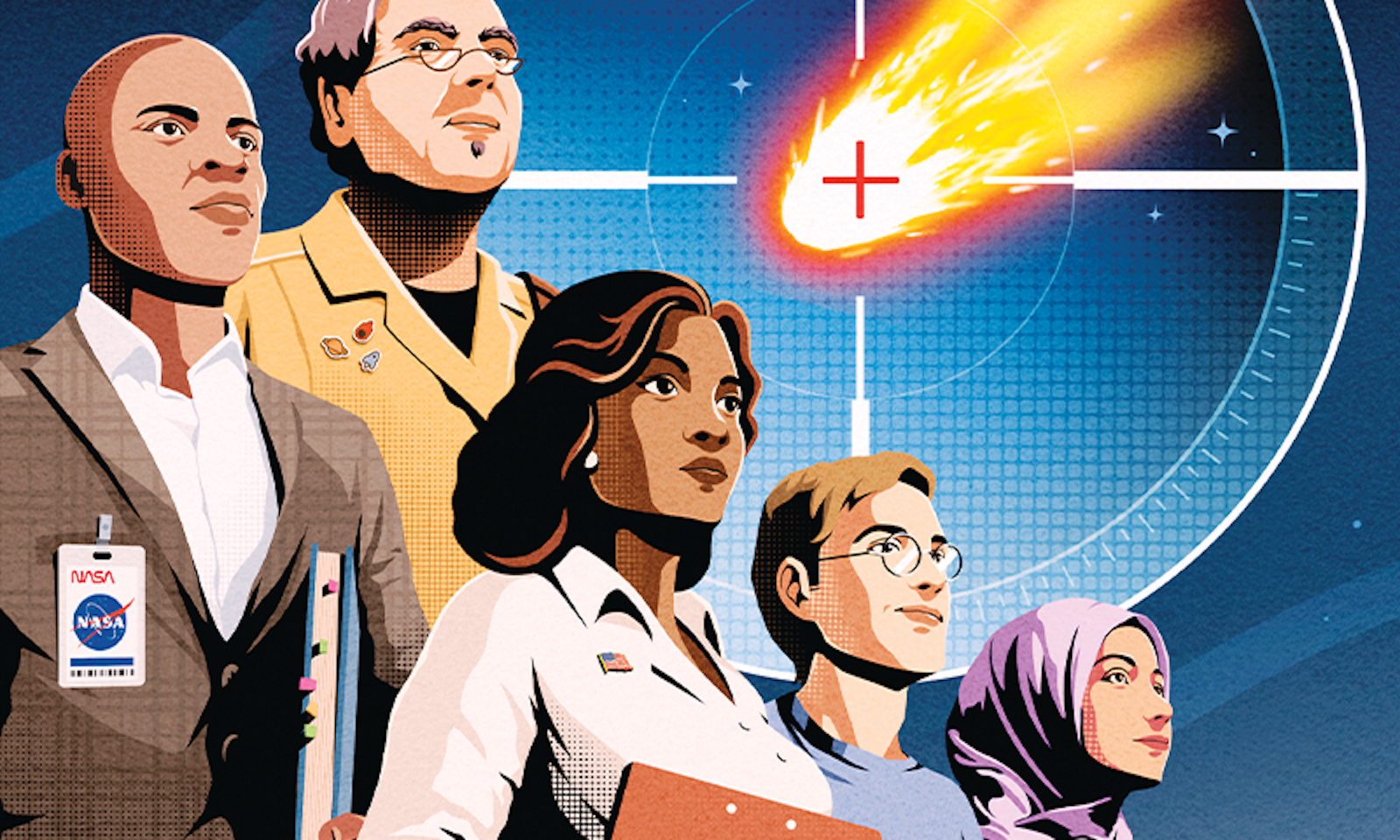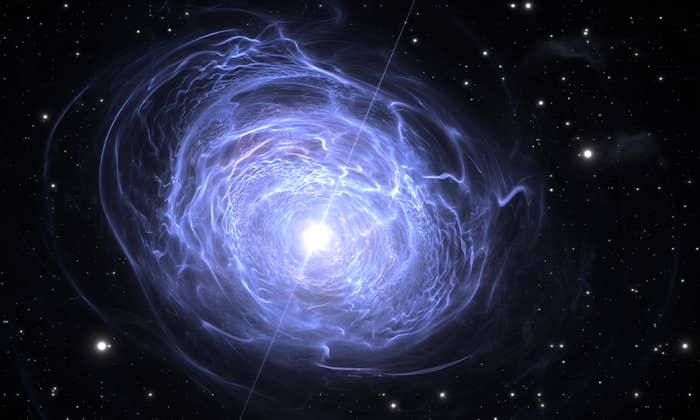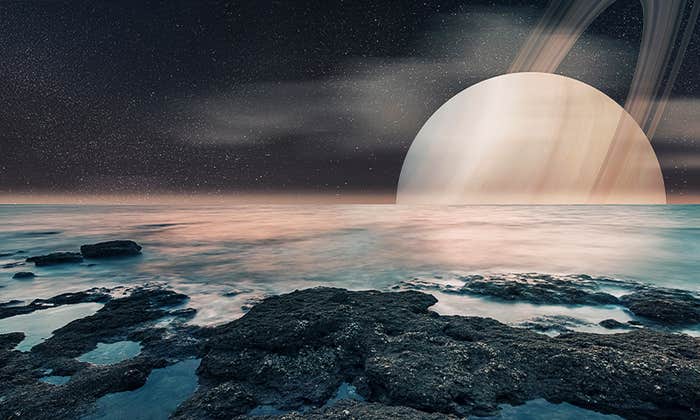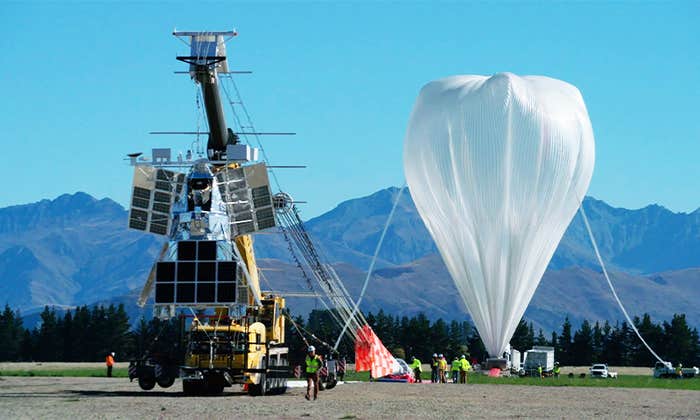Back in the early 1990s, Dave Tholen, an astronomer at the University of Hawaii, had an intellectual itch he couldn’t quite scratch. His specialty was finding and mapping asteroids—he had even served on an early “detection committee” that NASA had helped organize. The committee had recommended that Tholen search for asteroids in what’s known as the “opposition region” of the sky—the part opposite the sun, with Earth in between—because that’s where their models had suggested most asteroids might be found.
Tholen, however, had other ideas. “It seemed like circular reasoning,” he told me. “You’re basically saying that the best place to look in the sky is where we have been looking.” What if, he wondered, he were to search for asteroids whose orbits lay between the Earth and sun? “Something like Venus or Mercury, but on a more eccentric orbit,” he described it to me. If it became an impact hazard, he said, “we’d never see it coming, because it’s always in the daytime side of the sky.”
After years of struggling to secure funding, in 2004 he finally got the opportunity to perform his survey with the Subaru Telescope atop Hawaii’s Mt. Mauna Kea. On his last night on the telescope, he and a colleague spotted something moving quickly, typically the dead giveaway of a near-Earth object. They immediately flew to Arizona, where they continued their observations on Kitt Peak. But instead of picking up what they’d seen in the upper left quadrant of their instrument’s viewing screen—where they expected it—they spotted something in the lower right. The next night, further observation confirmed their initial suspicions: It was the same object they’d observed in Hawaii. The two sent their data to the Minor Planet Center, which christened the asteroid “2004 MN4.”
If the big one comes, and we stop it, we can trace saving the world to the hobbyists.
As more observations came in, and more computations were made, a realization dawned, Tholen said. “Hey, this is going to come really close in 2029, so close it could hit.” The asteroid was rechristened “Apophis”—the Greek name for an evil Egyptian deity. It was an estimated 1,300 feet in width, bigger than the object that streaked into Russian skies in 1908, unleashing 550 kilotons of downburst and obliterating 772 square miles of Siberian forest (the atmospheric pressure in Britain was affected). If Apophis were to hit, the blast force could be on the order of 1,000 megatons of TNT—the equivalent of many nuclear weapons, felt at once—flattening hundreds of square miles and, if it were to land in a densely populated region, killing millions.
Apophis, projected to have a 1 in 62 chance of striking the planet, surged to level 4 on the Torino Scale, a system developed to measure the risk posed by asteroids to Earth. This level indicates “a close encounter, meriting attention by astronomers”—virtually panic stations in the Near-Earth Object world. Astronomers globally scrambled to make calculations, while The New York Times wondered if “Apophis deserves to be added to our regular list of doomsday worries.” Soon, though, the threat began to diminish, as further calculations with optical and radar telescopes determined that its impact trajectory was merely a “close approach.”
Apophis was downgraded to level zero, becoming just one rock among many, orbiting the sun. Like an aging pop star, it fell off the “Risk List” of the European Space Agency’s Near-Earth Objects Coordination Centre—the Billboard charts of potential inter-planetary hazard. But in 2029, on Friday, April 13, Apophis will pass within 19,794 miles of Earth—that’s closer than the satellites that bring you your cable TV. It’s the biggest, closest asteroid to ever come our way with advance notice, visible to the naked eye. Tholen said that while Apophis’s current trajectory is not a cause for concern, its ultimate course is forever tinged with cosmic uncertainty, due to fluctuations in sunlight that give slight pushes to an asteroid, and other unpredictable gravitational phenomena.
Which means the asteroid will perpetually lurk on the margins of attention for the next generations of astronomers. “Can the tidal pull of the Earth change the shape of the asteroid? Can it change the spin state of the asteroid?” Tholen asks. “I’m going to take a wait-and-see attitude.”
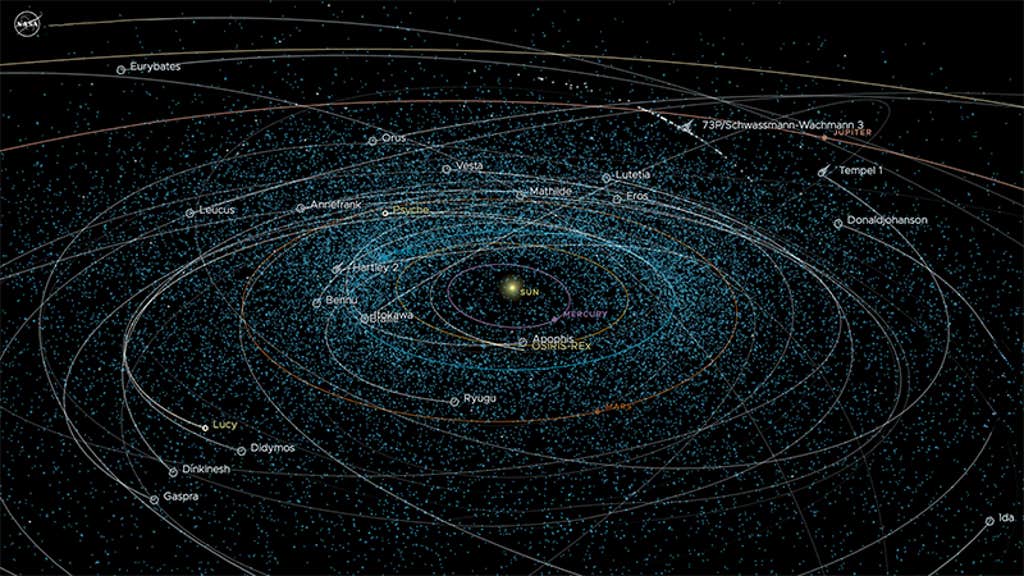
This has been the narrative that most of us know of modern near-Earth-object research. An asteroid is detected—it could be new, it could be something old, showing up in a new place. Its trajectory, deemed to come uncomfortably close to Earth, gives it an alarming-sounding ranking on a scale none of us really understand. The media responds with provocative headlines and shots from movies like Deep Impact. Gradually, science does its thing and determines the risk to be marginal. The world, like all the objects floating around it in space, moves on.
But tracking asteroids is less a game of absolute uncertainty than reducing uncertainty. Apophis was a false alarm this time, but maybe on its next approach—when you and I and Dave Tholen will have shuffled off this mortal coil—the numbers in our cosmic casino will come in differently. As someone who has actually dreamt of an asteroid striking the Earth (it’s not as uncommon a dream as you might think), I find this long game deeply fascinating.
In 2023, I set out to meet the people who spend a good part of their day thinking about a problem that seems quite far down in the global “hierarchy of needs.” Which it is—until it isn’t. How many other threats in the modern world, manmade or natural, can be said to be extinction-level events? After years of fevered discussion in small rooms, drafting out-there ideas via back-of-the-napkin sketches, scientists are finding a way to address this threat, literally, head-on. I wasn’t sure if this was sci-fi wargaming—fantasy football for the interstellar-minded—or an ultimately hopeful sign that the world, in the face of this, and other, imminent threats, could pool its collective intelligence to save itself.

Currently, according to NASA, there are 1,351,594 known asteroids in our solar system. The number, detailed on an agency web page, increases slowly but regularly, like one of those “Days Since Last Accident” signs in a factory, as astronomers continue to pick them out of the heavens. The bulk of these “rocky, airless remnants,” as NASA terms them, are dispersed throughout what’s known as the “main asteroid belt,” the torus-shaped sea of ancient flotsam between Mars and Jupiter.
Around 30,000 asteroids are designated “Near-Earth Objects,” meaning they have a trajectory that brings them within 0.03 astronomical units—around 28,000 miles—of Earth. Most of these asteroids will sail harmlessly by; and yet, over the last 100 years, there have been two meteor-caused atmospheric blasts that, had the geography and population density been a bit different, could have flattened entire cities and killed hundreds of thousands of people. Then there are all those space rocks that are too small to count. Some 100 of these palm-sized objects—call it space hail—survive their fiery descent and hit terra firma every day. Christian Köberl, a professor of impact research and planetary geology at the University of Vienna, told me that Earth, owing to its gravitational pull, is “in the middle of a cosmic shooting gallery.”
And yet, it wasn’t long ago that the threat of asteroids was barely on NASA’s radar. In 1980, the organization was aware of only 51 near-Earth asteroids. Asteroid detection and defense may never have got off the ground were it not for a handful of scientists and others in the aerospace community who were obsessed by the night sky flotsam. Someday, if the big one comes, and we stop it, we can trace saving the world to the hobbyists.
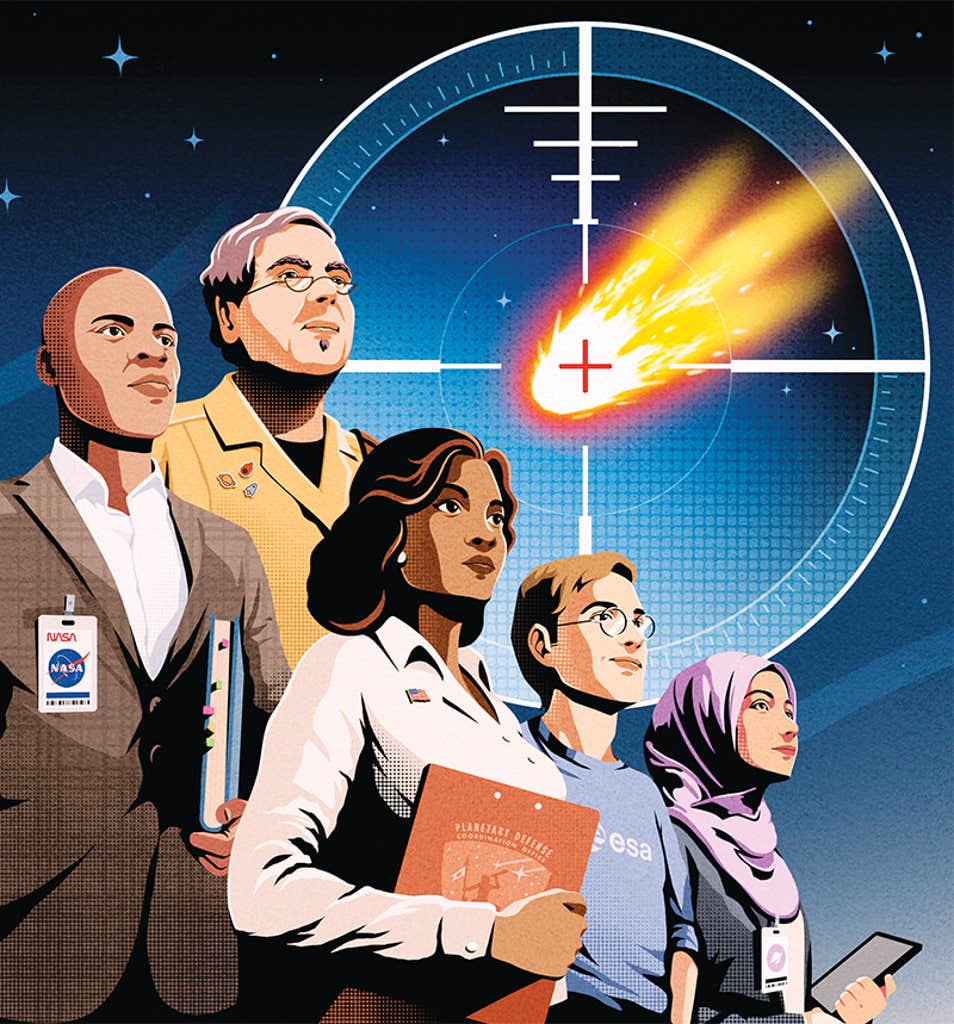
That same year, Lindley Johnson graduated with a degree in astronomy from the University of Kansas. Today, Johnson is the head of NASA’s Planetary Defense Coordination Office. When I met Johnson, he wore a blue pullover marked by an eye-catching embroidered badge that depicts a figure standing atop a castle tower, holding a telescope pointed at the night sky. Below were the words Hic Sevare Diem: “Here to save the day.” It was designed, Johnson told me, by Michael Okuda, the longtime designer for Star Trek. “NASA’s not real big on logos,” Johnson said, smiling. “But they made an exception.”
After college, Johnson joined the Air Force, where he worked on space surveillance systems. In the early 1990s, he was approached by Tom Gehrels, an astronomer at the University of Arizona, about leveraging new digital imaging technology to help hunt asteroids. Conversations with Gehrels and other asteroid hunters like astronomers Gene and Caroline Shoemaker further piqued his interest in tracking asteroids. “This really is a national security issue,” he recalled thinking at the time. “Being impacted by an asteroid could be a bad day not only for a particular country, but for the world.”
Not long afterward, the Air Force wanted to commission a study of what new capabilities it needed by the year 2020. Johnson stepped forward and said it needed to be prepared for the threat from an asteroid. Air Force staff were nonplussed. But Johnson persevered and wrote “Preparing for Planetary Defense.” “I almost didn’t get permission to write that paper,” he said. His colleagues “thought it was too abstract.”
Earth is in the middle of a cosmic shooting gallery.
In July 1994, the nascent movement had a foundational moment, when the comet Shoemaker-Levy 9 slammed into Jupiter in a destructive rain of fragments. It was the first live viewing of an object from space colliding with a planet. One of the pieces of the comet (“Fragment G”) left an Earth-sized crater. The idea of a momentous impact from space suddenly didn’t seem like something for the archaeological record (like the dinosaur-killing impact, 65 million years ago, in the Yucatan Peninsula). “A Threat to the Earth is No Longer a Joke,” declared The New York Times.
Later that year, Congress directed NASA to search for and track near-Earth objects larger than 1 kilometer. In 1998, the brief was expanded, tasking NASA to create a program “to detect, track, catalog, and characterize” at least 90 percent of near-Earth objects larger than 460 feet in diameter by the year 2020. Johnson helped lead the search effort. But as the deadline passed, the agency had only found a fraction of the asteroids that models suggested existed. “We’re only 42 percent complete after 25 years of searching,” Johnson said. “At the current rate it’ll take another 30 to 40 years to complete the catalog.”

Asteroid, in Greek, means “star-like,” which is how they look at a great distance. Finding them is a bit like the children’s game of “spot the difference.” You take repeated pictures of the same piece of sky, and “you look for what has moved,” said Richard Binzel, a professor of astronomy at MIT. From that blurred trace of light, he explained, you try to determine the asteroid’s “orbital elements”—a six-part set of coordinates that reveals not only where it’s going, but, by “linking” those coordinates with previous surveys, where it’s been. And the longer you watch an asteroid, for months, or better yet years, the better you can determine where it’s going. Binzel compared it to a baseball outfielder trying to catch a fly ball. “The ball first comes off the bat and the center fielder’s going, ‘Do I come in, do I come out?’ And then as you see more and more of the path, you are more and more certain.”
In 1999, Binzel helped design the Torino Scale. As with the Richter or Saffir-Simpson scale, the idea was to give scientists a jargon-free way of communicating severity. The range goes from level zero to Level 10—zero means no chance of collision or will burn up even if it sneaks into our atmosphere; 10 means that you shouldn’t even bother running for the hills, which will probably be underwater anyway. Every year, a handful of asteroids get a level 1 designation, which may start your pulse racing, but it simply means: “A routine discovery in which a near pass is predicted that poses no unusual level of danger.”
As more data come in, these asteroids are typically downgraded to level zero. But often not before a degree of alarmist news attention, exasperating scientists like Binzel. “Basically, a Tesla-sized asteroid passes through the Earth-moon system several times a week,” he said. “It’s just the nature of the business.” The asteroids have always been there, but “we’re just now increasingly able to see them.”
Mario Juric is one of the world’s leading asteroid hunters. A professor of astronomy at the University of Washington, Juric told me asteroids are the reason he’s an astronomer today. As a high school physics student in Zagreb, Croatia, he chanced upon a local DIY astronomy program whose mantra, as Juric described it, was “let’s go build telescopes, let’s go find asteroids.” Before long, he was writing software to automatically find near-Earth objects. “By the time I got to my senior year I’d already found thousands,” he says, and what had been a hobby became a career.
When Juric started spotting asteroids in the 1990s, there were only 10,000 or so known. The first, Ceres, had been discovered in 1801 by the star-cataloging Italian priest Guiseppe Piazzi (Ceres is so big that astronomers have since reclassified it as a dwarf planet). “It took us a couple of centuries to get to the first 10,000,” he said. “It took an additional 30 or so years to get to 1.3 million.”
In the next few years, that number will likely soar to 5 million, largely thanks to an effort—in which Juric has been a prime mover—to build a sky-sweeping telescope at the Vera C. Rubin Observatory in Chile (named for the pioneering American astronomer known for discovering dark matter, among other things). The state-of-the-art telescope utilizes the highest resolution digital camera in the world. It will scan and record the entire night sky every three days, as part of the Observatory’s 10-year Legacy Survey of Space and Time. (The Observatory reports science operations will begin in late 2025.) The new telescope will allow Juric to catalog near-Earth objects with unprecedented scope and acuity.
In this work, Juric is getting an assist from The Asteroid Institute, a project of the B612 Foundation. B612, named for the asteroid home of Antoine de Saint-Exupery’s Little Prince, is a nonprofit cofounded by ex-astronauts Ed Lu and Russell “Rusty” Schweickart in 2002 to serve as a kind of planetary watchdog against threats from space. Along the way, B612 has picked up supporters like Queen guitarist Brian May, an astrophysicist who helped start “Asteroid Day,” which is celebrated each year on June 30.
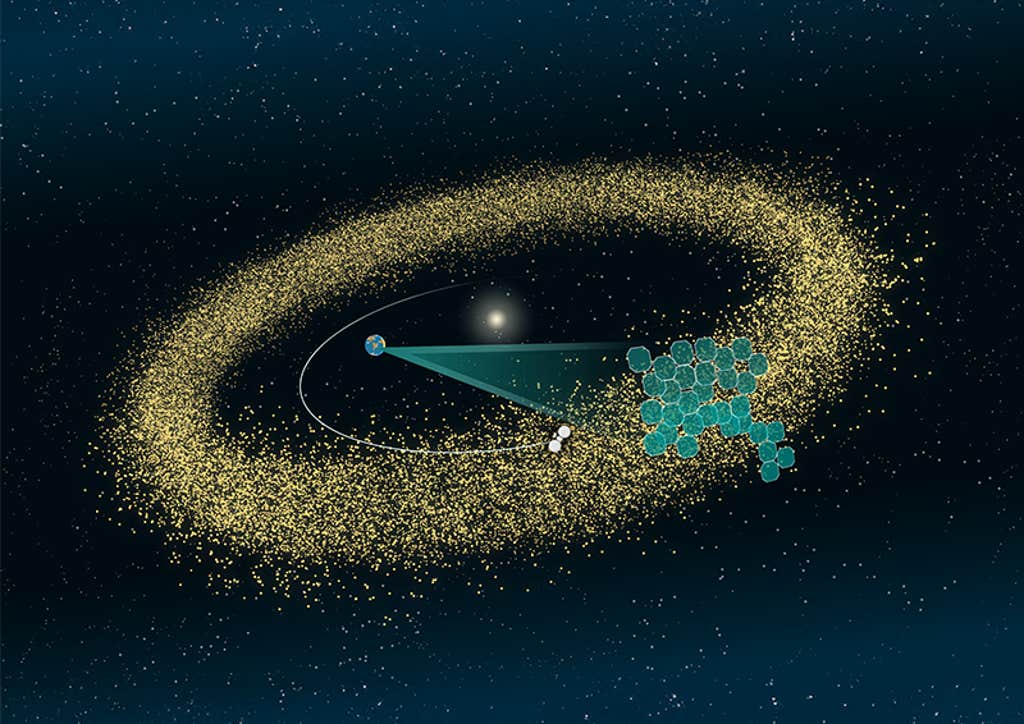
Lu, who worked for Google Maps once his space days were over, told me that the effort to build accurate street maps—to use in, say, self-driving cars—isn’t so different from tracking near-Earth objects. “Mapping needs to be constantly updated,” he said. “At some level, most things don’t change, but every once in a while, something does. It’s the same thing in the solar system.” Unlike ground mapping, however, in space, “everything is moving—you have to talk about trajectories, not locations.”
Further complicating matters is the fact that asteroids can go missing. Lu said it is not because “they are changing course drastically,” but rather that “in some cases, we don’t have a very good estimate of the orbit because we don’t have observations of those asteroids over a long enough period of time.” And once an asteroid has slipped out of view, the “longer it has been since we’ve last observed that asteroid, the more uncertain our prediction is of where to look.” There are some asteroids that were once known, he said, but now “we couldn’t even point a telescope at them.”
Lu said, “quite a lot have been lost, the ones that weren’t well tracked to begin with.” B612 aims to solve this problem by stitching together the past and present observations of the world’s telescopes into “one giant unified data set.” The longer you’ve been watching an asteroid, the further into the future you can predict its movement. Asteroid tracking is the ultimate long game.

Finding and tracking a potentially hazardous near-Earth object is one thing. But what if, to paraphrase Marx, you wanted not just to understand the world, but to change it? Or at least change its orbit.
For decades, scientists, engineers, and others in the planetary defense community have been theorizing on ways to interrupt the journey of an Earth-bound asteroid. One of the theoretical weapons in the quiver is the so-called “gravity tractor,” which entails directing a spacecraft toward an asteroid—not to destroy it, but to travel alongside of it, relying on its gravitational attraction to pull it to a new orbit, like an outer space version of a tugboat shepherding a container ship through New York Harbor. Another is an ion beam “shepherd,” in which a spacecraft would direct a high-velocity ion beam (a technology already used to help keep satellites on their proper orbit) toward an asteroid, hitting it with enough force as if the asteroid itself were equipped with an ion booster. Some have proposed blasting asteroids with lasers—not to demolish them, per the video game, but to deflect them. A more low-tech approach involves blasting the asteroid with large “paintballs”—changing the reflectivity of the asteroid which, over time, changes its rotation. Even getting a direct hit on an asteroid that is spinning can be a challenge, which is why one research team advocates a “tethered solar sail,” which, when attached to an asteroid, would effectively capture it.
None of these approaches—broadly grouped into “high impulse” and “slow push” solutions—have made it past the theoretical stage. That all changed in 2021 when the first rocket to deflect an asteroid was launched. The target was Dimorphos, a 5-billion-kilogram asteroid moonlet called Dimorphos, orbiting a larger asteroid called Didymos. Dimorphos was the perfect Goldilocks asteroid: sufficiently far away that it posed no actual risk to Earth, but close enough for a spacecraft to reach comparatively quickly.
A Tesla-sized asteroid passes through the Earth-moon system several times a week.
Nearly a year after it launched, on Sept. 26, 2022, to be exact, the rocket, called DART, for Double Asteroid Redirection Test, smashed into Dimorphos. It was a game of cosmic billiards. NASA shot its cue ball across the solar system at precisely at the right angle to knock Dimorphos off its trajectory. That shot represented a colossal human achievement. “Humanity first moved an asteroid,” as Nancy Chabot, a planetary scientist with Johns Hopkins University Applied Physics Laboratory, sums it up. This was, she says, no small task: “It was a huge challenge hitting a small asteroid, which you’ve never seen before, that’s 7 million miles away and moving at 6.1 kilometers per second.”
But DART has its limitations. The closer an asteroid comes to Earth, the greater the required angle of deflection, the bigger the force needed to deflect. And then there’s the size of DART itself: It weighed less than the famed defensive line of the 1985 Chicago Bears. What if an asteroid bigger than Dimorphos, and closer than Dimorphos, was headed our way? “We would need 100 DARTs,” explained Andy Rivkin, an engineer with the Applied Physics Laboratory. Or more because some of the DARTS “would probably fail.”
Caleb Scharf, senior scientist for astrobiology at NASA’s Ames Research Center, has written in Nautilus that even a relatively small-scale effort like DART—the “first significant, targeted engineering of the fundamental structure of our solar system in 4 billion years”—could lead to some “entirely unforeseeable emergency problems in the subtle chaos of orbital dynamics.” Like a high-order game of billiards, you might sink the eight ball, but end up scratching the cue ball.

Asteroid deflection is now a technological reality. But could we—and by we I essentially mean wealthy countries with space capabilities—summon the collective organizational and political will to mount a thoroughgoing defense in the face of a known threat? The specter of climate change suggests that scientific consensus of an actual hazard does not automatically translate into nations taking effective countermeasures.
Whatever the technical abilities we might possess to deflect or destroy an incoming asteroid, a host of factors, not the least of which are political, would need to be resolved briskly, and with international cooperation. To game out this scenario, a group called the Planetary Defense Conference—everyone calls it “the PDC”—has gathered biannually since 2004 to think about a problem that is statistically unlikely and entirely plausible.
In spring 2023, I traveled to Vienna, Austria, the site of the latest PDC meeting. In Boardroom D at the United Nations headquarters, Kelly Fast, head of NASA’s Near-Earth Objects Observations Program, informed the assembled audience that the agency had detected an asteroid—identified as 2023 PVC—that had a 1 percent chance of impacting the Earth on Oct. 22, 2036.

The audience—comprised of 150 scientists, disaster response managers, legal experts, former astronauts, ethicists—grew quiet, save for the frenetic dance of fingers on laptops. They were seated at long tables that radiated outward in a semi-circular arc, each station equipped with a simultaneous translation headset, some bearing country placards. The room, paneled in Scandinavian blonde wood, exuded a procedural air, maybe the faint whiff of some past war-crimes trial. Through a high window in the corner of the room, a group of badge-wearing visitors looked down.
The risk corridor, Fast noted, extended from the South Pacific to the Southern Indian Ocean, with huge swaths of North America, Europe, and Africa sitting in the impact zone. The damage will be “regional to continental.” She added, as if by consolation, “1 percent means there’s a 99 percent chance it wouldn’t impact.”
But what has put NASA on alert—as well as a whole constellation of affiliated governmental agencies and consortiums, ranging from the International Asteroid Warning Network to the United Nations Office for Outer Space Affairs to the Space Mission Planning Advisory Group—is the size of 2023 PVC. Paul Chodas, who heads the NASA Earth Observation program at the Jet Propulsion Laboratory, chimed in. “It could be in the range of 220 to 660 meters. If it’s a dark object, it could be much larger,” he said. The impact force, Chodas continued, could be in the range of “54 megatons to five and a half gigatons.” To put that into context, the atomic bomb dropped on Hiroshima had a blast yield of 15 kilotons—almost a rounding error compared to 2023 PVC.
Lorien Wheeler, who studies asteroid impact risk at NASA’s Ames Research Center, told the room to expect “a large ground impact or low airbust causing a highly destructive blast wave and fire.” Given the size of PVC 2023, she added, “the damage severities are expected to reach unsurvivable levels.” Things hardly get better from there, as gasses, aerosols, and materials are lofted into the atmosphere. “The climate feedback loops would be almost instantaneous,” said Lara Mani, with the University of Cambridge’s Center for Existential Risk. “Impact winter,” she called it.
If your vision for planetary defense includes a nuclear weapon, you have a problem.
The end of the world ends with a coffee break. As we sipped dark roast in the hallway, Planetary Defense Conference founder Bill Ailor told me the conference was launched on a whim. Ailor was working for the Aerospace Corporation back in the early 2000s when, he said, “an Air Force general came and basically said, ‘suppose an asteroid is headed for Earth? What are we going to do about it?’ ” At the inaugural conference, someone asked the question of how to notify the White House in the event a serious threat was detected. “There was no path at the time,” Ailor said (there now is).
Back in Boardroom D, attendees hashed out a response to 2023 PVC. Brent Barbee, an engineer with NASA’s Goddard Space Center, noted that an asteroid deflection mission could, owing to the size of 2023 PVC, require the launch of up to 1,300 “Falcon Heavies”—SpaceX’s signature rocket—to put the asteroid off an Earth trajectory. Anything less than a full deflection could dump the asteroid in an ocean, where it could trigger massive tsunamis.
Noting that anything less than a full deflection could be catastrophic, Detlef Kochny, a planetary defense specialist with the ESA, called for the “nuclear option”—using the blast force of a weapon to shift the asteroid. People had been thinking about using nuclear weapons against asteroids since the height of the Cold War. In 1967, for an exercise in “systems engineering,” an MIT professor conducted a seminar that theorized a nuclear counterstrike on an asteroid—1566 Icarus—that was due for a “close pass” of Earth in 1968 (a close pass still being 38 times farther than the moon). The researchers suggested that the six Saturn rockets then in production, each bearing 100 megatons of nuclear explosives, would be required to stop the asteroid—a bit problematic, as the largest nuke in the U.S. arsenal was 25 megatons. There’s another problem with the nuclear approach. It is illegal.
“If your vision for a planetary defense mission includes the use of a nuclear weapon, you have a problem,” said David Koplow, a law professor at Georgetown University. “Do not go beyond this point without your attorney.”
Still, after decades of relative inertia, “planetary defense,” said Matt Daniels, assistant director at the White House Office of Science and Technology Policy, “has hit an inflection point.” This year, the European Space Agency will launch “HERA,” a spacecraft that will autonomously rendezvous with Dimorphos to perform a post-mortem on DART’s bullseye and “turn the grand-scale experiment into a well-understood and repeatable planetary defense technique.” This year also sees the launch of NASA’s Near-Earth Object Surveyor infrared space telescope, as well as the completion of the survey telescope in Chile—two long-awaited instruments that will dramatically quicken the documentation of potential asteroid threats. Spacecraft from the U.S. and Japan are currently returning to Earth, laden with asteroid samples. What might have once seemed a fringe gathering in the small rooms of national laboratories now seemed more like some heady Davos of the near-Earth object scene.

So are the planetary defenders ready to Hic Sevare Diem—save the day? “The risk hasn’t changed,” said Johnson, director of NASA’s Planetary Defense Coordination Office. “The same asteroids that are there now were there a millennia ago.” What has changed, he suggested, “is our understanding of the risk.” And it takes a long time, he said, for that understanding to permeate through society. “The lights don’t suddenly go on and people understand this is something that the taxpayer’s money should be spent on,” he said. It doesn’t hurt that the universe, once in a while, throws up a reminder.
A few weeks after I returned to my home, in Madison, New Jersey, from the conference in Vienna, a meteor—a “mango-sized rock” as one outlet dubbed it—tore through the roof of a house in Hopewell, New Jersey, with such force that its rebound off the floor tore another hole through the roof. The 4.5-billion-year-old “hammer stone,” as such fragments are dubbed when they strike human-made things, landed less than an hour away from me—a mere Planck length in the scale of the universe. It seemed a little coda to the conference, a footnote from outer space: For all our increased power in patrolling the heavens, you can never quite be sure that nothing is going to fall out of the sky. ![]()
Lead illustration by Mark Belan















